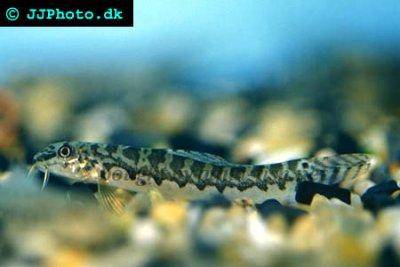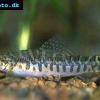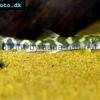Mottled loach - Acanthocobitis botia
Scientific name: Acanthocobitis botia
Common name: Mottled loach
Family: Nemacheilidae
Usual size in fish tanks: 10 - 11 cm (3.94 - 4.33 inch)
014
Recommended pH range: 6 - 7.5
Recommended water hardness: 10 - 18°N (178.57 - 321.43ppm)
0°C 32°F30°C 86°F
Recommended temperature range: 21 - 26 °C (69.8 - 78.8°F)
The way how these fish reproduce: Spawning
Where the species comes from: South Asia
Temperament to its own species: peaceful
Temperament toward other fish species: peaceful
Usual place in the tank: Bottom levels
Origin
The mottled loach originates from Asia where it inhabits the main waterways of the rivers in Pakistan, India, Nepal and Bangladesh.
Short description
The mottled loach can be found under various common names such as zipper loach, striped loach and even the sand loach. Use their Latin name to ensure that you purchase the correct species which is Acanthocobitis botia sometimes referred to as Paracanthocobitis botia. They are a peaceful species than be housed with other peaceful species for tank mates but make sure that all of the aquarium inhabitants require the same water parameters. Like all loaches they are bottom dwellers so when planning the tank set up leave them open swimming spaces on the substrate. Adult specimens should grow to just under 4 inches but always check when purchasing these fish as juveniles that they are feeding correctly and do not have sunken bellies.
Lifespan
If cared for correctly the expected lifespan for the mottled loach should average at approximately 8 years although some specimens may live slightly longer.
General care
These fish do not require a lot of space, they can be accommodated in a medium sized aquarium of at least 2.5-3.0 feet in length x 1 foot width (75-90 cm x 30 cm), if keeping more than one specimen it may be wise to choose the larger option allowing them to set their own territories. Sand or smooth gravel can be used for the substrate and any plants added to the aquarium should not be uprooted. Use a filtration system that is rated for the water volume of the aquarium and keep the water flow at a steady pace by careful positioning of the outlet nozzle. The water temperature should range between 21- 26°C (70-79°F) and the pH should range between 6.0-7.5. The mottled loach, as expected are bottom dwellers, if you keep these fish it may be wise not to add other large bottom dwellers as they can be intimidated by more aggressive species. For the bottom level you can add a small group of Corydoras and on the higher levels they will be fine with other peaceful species of fish such as most of the cyprinids or rasboras. Always keep the water quality high and perform regular water changes of at least 10% weekly.
Feeding
In the wild these fish predate on small insect life and larva, they do require a varied diet in the aquarium to keep them at their best so use small sinking pellets for the staple diet but this should be varied with regular treats of live or frozen foods. Artemia or blood worms are ideal but being bottom dwellers make sure they get their share of the food. It often pays to feed in the evenings when the other tank mates from higher levels are more sluggish and will allow the food to reach the substrate.
Sexing
Mature females will have a fuller body shape, mature males will also develop a slit below there eyes which is not present in the females.
Breeding
If these fish breed in the aquarium it is purely a case of hit or miss with no intervention from the keeper. In the wild it is believed that these fish are egg scatterers and show no great parental care. The will normally deposit their eggs in the early hours of the morning and the eggs have a sticky coating allowing them to stick to plants etc. Any eggs that are free floating will sink to the bottom of the waterway and the fry should emerge after a few days.
Pictures
Pictures of Mottled loach were bought by aqua-fish.net from jjphoto.dk.


 Banded
Banded  Schistura
Schistura